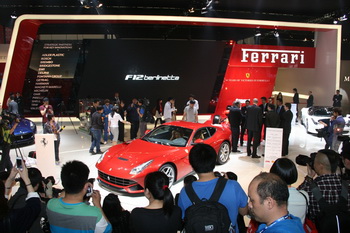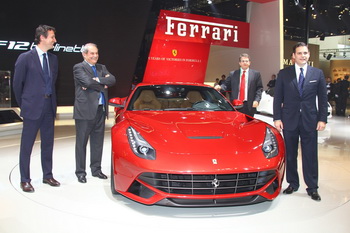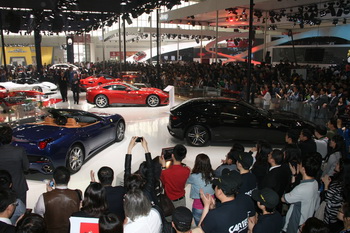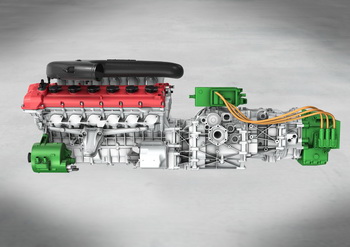

 |
|
After a successful unveiling at Geneva, the
F12berlinetta, the first in a new generation
of Maranello’s flagship 12-cylinder cars,
has made its Asian debut this week at the
Beijing International Motor Show. |
|
|
|
 |
|
The other important unveiling at Beijing is
the evolution of the HY-KERS project adapted
to a mid-rear engine layout. The powertrain
on display consists of a 12-cylinder engine
and dual-clutch gearbox coupled to an
electric motor. A second electric motor is
dedicated to the auxiliary systems and is
located in front of the V12. The two
electric motors are connected to the
batteries which can be positioned in the car
in line with the available space and final
configuration. |
|
|
|
After a
successful unveiling at Geneva, the F12berlinetta, the
first in a new generation of Maranello’s flagship
12-cylinder cars, has made its Asian debut this week at
the Beijing International Motor Show. The event is also
hosting the world première of the evolution of the
HY-KERS concept, coupling hybrid technology with
mid-rear architecture to cut fuel consumption and CO2
emissions on the combined cycle by 40 per cent whilst
boosting performance.
The F12berlinetta is the most powerful and
high-performance road-going Ferrari ever. Powered by a
truly exceptional V12 engine, it is built around an
evolution of Ferrari’s transaxle lay-out and features
cutting-edge components and electronic controls. The
F12berlinetta also boasts extremely advanced
aerodynamics and a design that exudes an innovative yet
classic beauty.
The car’s wheelbase is shorter, its engine and driver
position are lower and a new suspension and gearbox
layout has yielded a more compact tail section. The
result is a shorter, lower and narrower car than the
previous V12 coupé. It also boasts perfect weight
distribution (54% over the rear axle) and a lower centre
of gravity further back in the chassis.
With a Fiorano lap time of 1’23’’, 0-100 km/h
acceleration in 3.1 seconds and 0-200 km/h covered in
8.5 s, the F12berlinetta delivers absolutely benchmark
performance. The handling balance achieved ensures
maximum driving involvement even at low speeds, a
feature thus far the sole domain of mid-rear-engined
cars. The sporty handling is equally nimble and
responsive on the road as on the track.
Great attention was paid to reducing fuel consumption
and emissions which have been slashed by 30 per cent,
with the result that the F12berlinetta tops its segment
in terms of efficiency with 15l/100 km and 350 g/km of
CO2.
The other important unveiling at Beijing is the
evolution of the HY-KERS project adapted to a mid-rear
engine layout. The powertrain on display consists of a
12-cylinder engine and dual-clutch gearbox coupled to an
electric motor. A second electric motor is dedicated to
the auxiliary systems and is located in front of the
V12. The two electric motors are connected to the
batteries which can be positioned in the car in line
with the available space and final configuration.
The objective of this configuration is to create a
sports car that, thanks to the integration with the
electric motors, increases power while at the same time
reducing emissions. The KERS features new, smaller and
lighter electronic components which come close to
achieving the declared target of 1 KW per kg of extra
weight added by the hybrid system.
Technological transfer from F1 was fundamental to the
design, engineering and construction of an innovative
electric motor used to optimise the car’s longitudinal
and lateral dynamic characteristics, namely torque
management, traction control and brake distribution, to
the benefit of sportiness and driving pleasure.
The HY-KERS’ electric motor delivers power using one of
the gearbox’s two clutches and is mated to one of the
two main shafts. The result is instantaneous, continuous
power delivery between the electric motor and petrol
engine. During braking, the electric motor acts as a
generator, using the kinetic energy from the negative
torque to recharge the batteries. This crucial task is
managed by a dedicated ECU, also F1-derived, which not
only controls the electric motor, but also governs the
power to the auxiliary systems (power steering, brake
servo, air conditioning, onboard systems).
Work on the system has now reached the end of the
experimental phase and the development phase will
commence in the coming months. With the same nominal
power output of a normal ICE, the HY-KERS system will
enable Ferrari to reduce emissions by 40 per cent over
the combined cycle.
On the first day of the show Ferrari CEO
Amedeo Felisa stated China's importance for the
manufacturer from Maranello, which has enjoyed an
increase in sales that is higher than the 2011 market
average: "Last year we sold 500 cars in mainland China,
with a growth of 75% compared to the reference market,
which grew at 65%," Felisa confirmed. "Greater China is
now the second most important market for Ferrari in the
world." At a conference with Chinese reporters Felisa
underlined the country's fundamental role for the
Prancing Horse. "This year we'll celebrate the 20th
anniversary of the first car sold in Beijing. To
celebrate this landmark a big permanent exhibition
dedicated to Ferrari will open at Shanghai's World Expo
Park in the Italia Center in May. There we'll present a
special series of our 458 Italia model with a special
livery, sporting the "longma", the characteristic
Chinese symbol, the legendary dragon-horse, the perfect
symbol of Chinese culture and Ferrari."
"In mainland China,"
Felisa concluded, "Ferrari's network of 15 dealerships
will be expanded to 20 by the end of 2012."
|
|
|